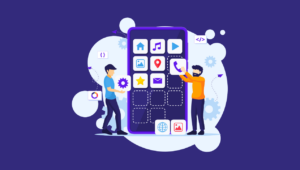The digital era has ushered in a paradigm where mobile apps are not just a luxury but a necessity for businesses aiming to thrive. The burning question that arises for entrepreneurs, SMEs, and large corporations alike is: What’s the real cost of bringing a mobile app to life? This extensive article aims to unravel the intricacies of mobile app development costs, blending in real-world examples and specific figures to provide a detailed financial compass for your next digital undertaking. Learn how much does it really cost to build a mobile app and have a deep dive into budgeting and examples for application development prices.
1. The App’s Scope: A Determining Factor
The journey in app cost estimation begins with understanding its scope. Simple apps like calculators or timers might cost around $10,000 to $20,000. Medium complexity apps, such as a basic e-commerce app or a social networking app, can range from $50,000 to $120,000. High-end apps with advanced features, like Uber or Instagram, can skyrocket anywhere between $200,000 to $500,000. The key is to align your app’s features with your business objectives and user needs.
Beyond basic feature lists, the scope of an app encompasses its target audience, market research, and potential scalability. For instance, an app designed for a niche market might require specialized features, potentially increasing the cost. Market research can add another $5,000 to $15,000, depending on the depth and breadth of the study. Scalability considerations, like preparing for a sudden influx of users, also factor into the development cost.
2. Platform Choices and Their Impact on Mobile App Cost

The decision between iOS, Android, or cross-platform development significantly influences the budget. Developing a native app for iOS might cost around $30,000 to $100,000, while Android apps can range from $20,000 to $80,000. Opting for cross-platform technologies like React Native or Flutter could push the budget to $50,000-$150,000 but offers a broader market reach.
The decision between iOS and Android isn’t just about reach; it’s also about demographic targeting and market behavior. iOS users tend to spend more on apps, which can influence the monetization strategy. Also, the choice of platform affects the development timeline. iOS apps typically have a quicker approval process in the App Store compared to Android apps in the Google Play Store, potentially reducing time-to-market budgeting for a mobile app.
3. Designing for Success: UX/UI Costs
A visually appealing and user-friendly design is vital for app success. Custom graphics, icon sets, and user interface animations can add $5,000 to $20,000 to the development cost. Complex apps with more sophisticated UX/UI design requirements, like Airbnb or Spotify, could have design costs upwards of $40,000.
Design costs also encompass branding elements, like logo design and brand color schemes. These elements can enhance user experience and brand recognition, potentially increasing user retention rates. For an app requiring bespoke branding, this can add an additional $2,000 to $10,000 to the design budget.
4. Backend Development: The Cost of Robustness on Mobile App Cost
The complexity of your backend infrastructure, including database management, server-side logic, and cloud storage, can significantly add to the cost. For a medium-scale app, backend development can cost between $25,000 and $50,000. Apps requiring high-level security features or complex data processing, like banking or medical apps, might need backend development budgets exceeding $100,000.
In the case of apps handling sensitive user data, like health or financial information, additional investments in security protocols are essential. Implementing advanced security measures can increase the backend development cost by 20-30%. Scalability is another factor; ensuring that the app can handle growth in user numbers without performance issues is crucial, especially for social media or e-commerce apps.
5. The Inevitable: Maintenance and Updates
Post-launch, the app requires regular updates, bug fixes, and perhaps new features, accounting for about 15-20% of the initial development cost annually. For an app costing $100,000 to develop, expect to spend $15,000 to $20,000 per year on maintenance.
Maintenance also includes handling unexpected downtime, server outages, or security breaches. Setting aside a contingency budget for these unforeseen challenges is essential. For high-traffic apps, this contingency budget can be as high as 10% of the original development cost annually.
6. Additional Cost Factors
Other elements impacting the total cost include app store fees, payment gateways, third-party integrations, and compliance with legal standards like GDPR, which alone can add a few thousand dollars. For instance, integrating a payment gateway like Stripe or PayPal can cost an additional $10,000 to $25,000.
Considering third-party services, such as analytics tools or customer support chatbots, can provide valuable insights and improve user satisfaction but add to the costs. Compliance with industry-specific regulations can be especially costly. For example, meeting healthcare industry compliance standards like HIPAA in the US can add $20,000 to $40,000 to the development costs budgeting for a mobile app..
7. The Outsourcing vs. In-House Development Dilemma on Mobile App Cost
The choice between outsourcing and in-house development is crucial. In-house development offers control but can be expensive, easily reaching $500,000 for a complex app. Outsourcing to countries like India or Ukraine might reduce the cost to $20,000-$40,000 for a basic app and $70,000-$150,000 for a more complex one, without significantly compromising quality.
While outsourcing can be more budget-friendly, it often involves hidden costs like communication overheads, time zone differences, and cultural barriers. These can impact project timelines and overall quality. In contrast, in-house development ensures better communication and control but requires investments in team building and technology infrastructure.
8. Real-World Examples: From Concept to Reality
Consider WhatsApp, a relatively simple app in its initial stages, which might have cost around $250,000 to develop. In contrast, a feature-rich app like Uber, with its complex algorithms, GPS integration, and payment systems, likely had initial development costs exceeding $1 million.
Analyzing successful apps like Tinder or Snapchat reveals that their initial development costs were just the tip of the iceberg. The major part of their budget was allocated to marketing, user acquisition, and iterative improvements based on user feedback. For such social media apps, marketing and user acquisition costs can match or even exceed initial development costs.
Conclusion
Ultimately, the cost of mobile app development is a spectrum influenced by a myriad of factors including functionality, design, platform, and ongoing maintenance. A basic utility app might cost $10,000, while a feature-rich application can go well above $500,000. It’s crucial to have a precise understanding of your app’s requirements and choose a development route that aligns with your financial constraints and business aspirations budgeting for a mobile app.
Key Takeaways
- Assess the app’s scope and feature set for accurate cost estimation.
- Select the platform wisely, considering target audience and budget.
- Prioritize UX/UI design for user engagement and retention.
- Be prepared for significant backend development costs for complex apps.
- Budget for ongoing maintenance and updates.
- Consider outsourcing as a cost-effective solution without compromising on quality.
Building a mobile app is a significant financial undertaking that demands judicious planning and a strategic approach. With insightful planning and execution, your app can not only fulfill but exceed your digital goals, ensuring a robust return on your investment.








